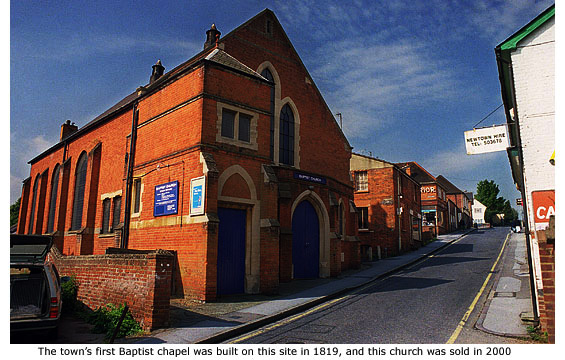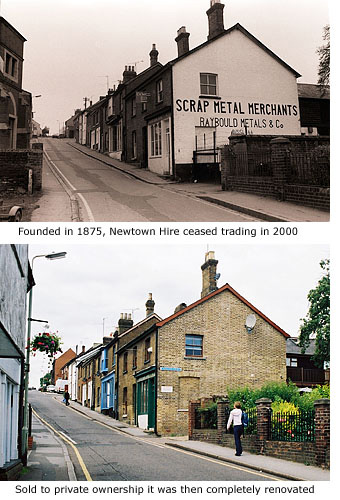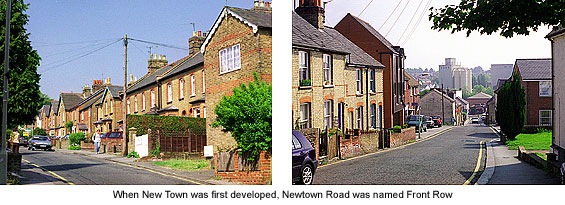|

When the Act of Toleration was passed in 1689, nonconformist religions were quick to take a foothold in Bishop's Stortford. First came the Quakers and Congregationalists, and then the Baptists. The history of the Baptists goes back to the Reformation of the Church in Europe in the 16th century, when three main groups came to the fore: Lutherans, Calvinists, and Anabaptists. The latter, who were most prominent in Switzerland, Holland and Germany, stood alone in three beliefs: that only adults should be baptised; that the Church and State should be separate entities; and that personal faith should be tolerated by all. Such views however were not shared by Catholics or Protestants, and Anabaptists were persecuted by both religions.
The most notable example of this was at Munster, Westphalia in Germany – centre of the Anabaptist movement. Members there suffered greatly at the hands of the city's Catholic masters but in 1532, after the Lutheran chaplain Bernhard Rothmann encouraged the usually pacific Anabaptists to rise up, Munster soon became a magnet for Anabaptist refugees. Two of their number from the Netherlands, Jan Matthy and Jan of Leiden, then took charge of the city in 1534, calling it 'The New Jerusalem', and proceeded to institute theocratic rule. They also incited a bloody purge of the old order. When the city was finally taken after a year-long siege by the exiled bishop, he ordered the massacre of all Anabaptist therein. Those responsible for leading the rebellion were not true Anabaptists, but enemies of the Gospel (particularly Catholics) were quick to associate all Anabaptists with the bloody events at Munster. English officials of the time used the word Anabaptist as a generic term for any European sect with a radical theology, and though small numbers of Anabaptists appeared in England, the threat of death and banishment prevented them from aquiring any importance here.
The first English Baptist Church was formed in Amsterdam in the home and bakery of a Mennonite (the largest Anabaptist group) named Jan Munter. A group of dissenters of the Puritan tradition of English separatists, led by John Smyth (a former minister of the Church of England) and Thomas Helwys, had fled to Holland from Gainsborough, Lincolnshire, in 1605. It was Smyth who was the first to baptise but Helwys who went on to form the first Baptist Church in England in 1612 at Spitalfields, London – ironically the same year John Smyth died. Helwys later published a book calling for tolerance and freedom of conscience for all faiths and even sent a signed copy to James I. He read it and then had Helwys imprisoned in Newgate jail where he died in 1616.
It is true to say that English Baptists were influenced by Anabaptists, but only by their literature. They, like the true Anabaptists were pacifists, and the violence and radicalism shown at Munster played no part in their beliefs and teaching. Despite this, Baptists, like Quakers, were still persecuted throughout the 17th century, only being tolerated during the period of the English Civil War (1642–46) and, later, under Oliver Cromwell’s Protectorate (1653–1659).
When persecution (though not all restrictions) of these ‘Dissenters’ was finally ended in the 18th century, Methodism began to flourish. Inspired by this, Baptists such as Samuel Deacon and Dan Taylor became involved in the evangelical revival, Dan Taylor forming a separate New Connection of General Baptists in June 1770. Their work was centred in emerging industrial communities.
There were, in fact, two streams of Baptist life based on two theological understandings of the death of Christ. General Baptists believed Christ died for everyone in general; the Particular Baptists (who emerged in the 1630s), believed he died for an elected few. The two groups ran in parallel, but in 1813 a General Meeting of the Particular Baptist Denomination was established. In 1832 it set aside the foundational Calvanist 1689 confession of faith and the New Connection of General Baptists joined with them – forming the Baptist Union. The more extreme Calvinists left to form the Strict and Particular Baptists. As a result of these changes the number of Baptists in Britain grew from 37,000 in 1800, to 125,000 by 1837.
In 1809 Bishop's Stortford had just two baptist residents out of an estimated population of 2,500. But around this time another baptist apparently took up residence, and by 1814 their number was such that one John Phipp (1738–1818) had his house licenced for preaching. The ever-growing congregation then hired a barn at Phipp's Yard in South Street, owned by beer retailer and brewer, Thomas Phipp (See Guide 13 – Lower South Street East).
In 1819 the first Baptist chapel was built on the site of the present church in Newtown Road, on a piece of ground known as Sandpit Field. Rules set up for church government suggest these first baptists were of the Particular Baptist tradition, but in 1832 they joined the *Baptist Union. The resulting increase in the congregation forced the building of a gallery the following year, and further enlargement of the chapel in 1841 and 1869. Thirty years later it was pulled down and replaced by the present church. This was built by local builder Joseph Glasscock at a cost of £2,000, and went on to serve the Baptist community for 101 years.
But come the new millennium a severe lack of space here forced the church to sell the property and seek an alternative site, and in January 2000 the congregation took up temporary accommodation at the Bishop’s Stortford High School in London Road. The exterior of this former church still retains its Victorian character but the interior has now been transformed for residential and business use. At the present time Bishop's Stortford's Baptist church has still to find a permanent home.
|
|
In May 2005, two skulls and other bones were found by workmen while digging a trench behind the church. The remains were later confirmed to be more than a century old and had come from the former Baptist burial ground. Prior to major reforms in 1853, only members of the Church of England could be laid to rest in consecrated ground, and so each church had its own cemetery (See Guide 14 – New Cemetery). Baptist church records show that 105 burials took place here between the time the first chapel was built in 1819 and the reforms of 1853. Of these, 43 were children – an indication to the high mortality rate of infants during the 1800s. The burial ground was closed officially in 1855.
*The Baptist Union of Great Britain is a union of independent churches, associations and colleges in England and Wales. At the present time, some 2150 churches cater for a membership of almost 140,000. It is foremost a mission agency, aiming to encourage, support and initiate effective strategies in evangelism; to develop a distinctive Baptist identity; and promote the sharing of people, money and other resources.
My thanks to Rev John Walford of Bishop's Stortford Baptist church, for additional information regarding the foundation of the Baptist Church.
 Careless Court, directly opposite the former church, takes its name from the Careless family whose business, Newtown Hire, was founded on this site in 1875 and run continually by family members until its closure in February 2000. Careless Court, directly opposite the former church, takes its name from the Careless family whose business, Newtown Hire, was founded on this site in 1875 and run continually by family members until its closure in February 2000.
Two small terraced houses near to the corner of Portland Road – Nos 14 and 16 – were used as a bicycle repair shop until the late 1980s, and on the south side of the road the long established Priors electrical shop finally closed for business in 2001, the premises since being converted into a private house. Nearby, newly built Oliver Court (2002) replaced a 19th century building.
Between 1876 and 1884, the Cricketers Arms public house (also known as The Cricketers) stood on the north-west side of Newtown Road at its junction with Portland Road. The landlord at that time was Joe Silcock, a well-known cricketer in the town in the 1860s, who often helped with cricket coaching at the Nonconformist Grammar School. Wisden’s Cricket Almanac of 1866 records that in a match between a ‘twenty-two’ of Bishop’s Stortford and an all England eleven, Silcock made a duck in the first innings and was not required to bat in the second innings. Presumably his performance on other occasions was somewhat better, otherwise he wouldn’t have been quite so well known.
|





 Careless Court, directly opposite the former church, takes its name from the Careless family whose business, Newtown Hire, was founded on this site in 1875 and run continually by family members until its closure in February 2000.
Careless Court, directly opposite the former church, takes its name from the Careless family whose business, Newtown Hire, was founded on this site in 1875 and run continually by family members until its closure in February 2000.